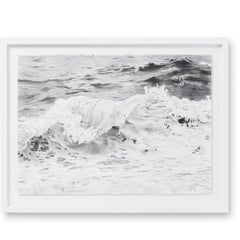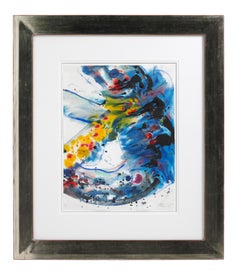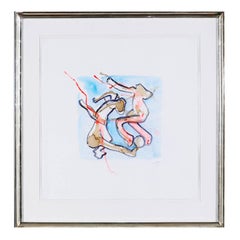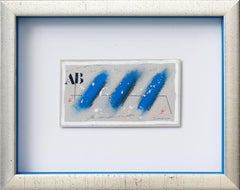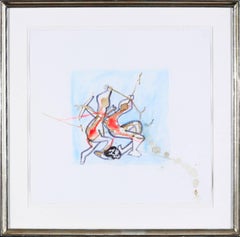Galleri GKM AB Abstract Drawings and Watercolors
to
1
3
2
Overall Width
to
Overall Height
to
4
2
1
3
3
2
1
4
2
4
2
2
1
1
3
1
1
1
2
6
Le jour se lève
By Philippe Huart
Located in Malmo, SE
Signed, titled and dated on the verso.
Acquired directly from the artist.
Free shipment worldwide.
Working on a variety of perceptual levels, Philippe Huart lets one visit his intim...
Category
2010s Abstract Abstract Drawings and Watercolors
Materials
Paper, Pen, Graphite
Foot Musik
By Roberto Matta
Located in Malmo, SE
Frame size 76x78 cm.
Free shipment worldwide.
Acquired directly from the artist.
Archive number (P90/41)
“The heart is an eye,” writes Nobel laureate Octavio Paz in an essay on Matta’s paintings. Matta creates a world coloured both by a sunny faith in the future and by visions of impending doom.
Roberto Sebastian Echaurren Antonio Matta, who died aged 91 on 23 November 2002, was born in Santiago, Chile, on 11 November 1911 into a family with Spanish, French and Basque roots, and raised in an atmosphere of religiosity. By the age of 21 he had graduated and begun work as an architect, but his leisure time he devoted to sketching and painting. In 1933 he travelled to Europe for the first time, visiting Greece, Yugoslavia, Italy and other countries, and subsequently taking the initiative to collaborate with the architect, Le Corbusier. As time passed, however, Matta’s enthusiasm for a career in architecture waned, and he began to devote himself full-time to art, making early acquaintances with surrealists such as Max Ernst, Salvador Dalí, André Breton and others.
Between 1939 and 1948 Matta, like many of his artistic contemporaries, lived in self-imposed exile in the USA, but, after almost 10 years’ absence from Europe, he returned to make first Rome and then, a few years later, Paris his home. Throughout most of the rest of his life Matta commuted between his studio in Paris and his creative refuge in the monastery outside Rome. And it is here, in Italy, that he produced his greatest paintings.
Matta’s first retrospective in Sweden was organised in 1956 when his works were exhibited in what was then Galerie Colibri – run by, among others, the artist C O Hultén...
Category
1990s Surrealist Drawings and Watercolor Paintings
Materials
Mixed Media, Gouache
SF 89-153.
By Sam Francis
Located in Malmo, SE
Artwork size: 67 x 51 cm.
Frame size: 112 x 97 cm.
Free shipment worldwide.
Archive number SF 89-153 in the Sam Francis Foundation.
Stamped with the Sam Francis Estate logo and stamped signature on verso.
Sam Francis’s paintings are a journey into a dream, a voyage into the landscapes of the soul where colours are lights on fire.
Alongside names such as Jackson Pollock, Willem de Kooning and Franz Kline, Sam Francis is an artist who has succeeded in demonstrating a total mastery of abstract expressionism’s impassioned and spontaneous genre.
The explosions of colour – red, blue, green and yellow – the streaks, strokes and bold lines of his pictures are the physical synthesis of the deepest crevices of the soul. His colours create rhythmical motifs that, characteristically enough, can be called the “musicality” of his paintings.
The work of Sam Francis provides a visible meeting place for the conscious and the unconscious. His pictures are the cross-fertilisation of what has already been experienced with what exists still only as desire, a struggle between melancholy and merrymaking.
Influenced by C.G. Jung, the father of psychoanalysis, Sam Francis spent a large portion of his life exploring the premise that dreams, instincts and intuition provide, the keys which unlock the mysteries and meaning of our inner lives. He was also fascinated by the four ancient elements – earth, water, air and fire – which developed into a leitmotif in his work.
Sam Francis was born in San Mateo in California, USA in 1923. After starting to paint at the age of around twenty, he soon found himself increasingly consumed by the power of art.
He spent much of the 1950s in Paris, from where he not only made frequent excursions to a number of European cities, but also embarked on many journeys to South America and Asia.
He continued to move from place to place, primarily in the USA and Japan, right up until his death in 1994.
Sam Francis’s first...
Category
1980s Contemporary Abstract Paintings
Materials
Paper, Acrylic
$101,131
Foot Musik.
By Roberto Matta
Located in Malmo, SE
Pastel, gouache and coffee on paper.
Artwork size: 58 x 56 cm.
Frame size: 78 x 76 cm.
Free shipment worldwide.
Acquired directly from the artist.
Archive number (P90/37)
“The heart is an eye,” writes Nobel laureate Octavio Paz in an essay on Matta’s paintings. Matta creates a world coloured both by a sunny faith in the future and by visions of impending doom.
Roberto Sebastian Echaurren Antonio Matta, who died aged 91 on 23 November 2002, was born in Santiago, Chile, on 11 November 1911 into a family with Spanish, French and Basque roots, and raised in an atmosphere of religiosity. By the age of 21 he had graduated and begun work as an architect, but his leisure time he devoted to sketching and painting. In 1933 he travelled to Europe for the first time, visiting Greece, Yugoslavia, Italy and other countries, and subsequently taking the initiative to collaborate with the architect, Le Corbusier. As time passed, however, Matta’s enthusiasm for a career in architecture waned, and he began to devote himself full-time to art, making early acquaintances with surrealists such as Max Ernst, Salvador Dalí, André Breton and others.
Between 1939 and 1948 Matta, like many of his artistic contemporaries, lived in self-imposed exile in the USA, but, after almost 10 years’ absence from Europe, he returned to make first Rome and then, a few years later, Paris his home. Throughout most of the rest of his life Matta commuted between his studio in Paris and his creative refuge in the monastery outside Rome. And it is here, in Italy, that he produced his greatest paintings.
Matta’s first retrospective in Sweden was organised in 1956 when his works were exhibited in what was then Galerie Colibri – run by, among others, the artist C O Hultén at number 36 Södra Förstadsgatan in Malmö, Sweden. This was also the time when Matta began to collaborate with poets and other artists in Sweden. He produced the illustrations for Lasse Söderberg’s first anthology of poems, Akrobaterna (“The Acrobats”), published in 1955, and was also responsible for the cover of the Swedish art and literary magazine Salamander.
In 1959 the first museum exhibition of Matta’s work in Europe was arranged at the Museum of Modern Art (Moderna Museet) in Stockholm. Held under the aegis of Pontus Hultén, it was entitled “Fifteen Forms of Doubt” and included 15 or so gigantic paintings...
Category
1990s Abstract Mixed Media
Materials
Mixed Media
Trois bleus en diagonale.
By James Coignard
Located in Malmo, SE
Acquired directly from the artist.
Unique artwork.
Artwork size: 9,5 x 17 cm.
Frame size: 27 x 34 cm
Frame in silver.
Museum glass anti-reflective.
Free shipment worldwide.
“With ju...
Category
Early 2000s Abstract Mixed Media
Materials
Mixed Media
Foot Musik
By Roberto Matta
Located in Malmo, SE
Artwork size: 56 x 58 cm.
Frame size: 76 x 78 cm.
Free shipment worldwide.
Archive number (P90/36)
Acquired directly from the artist.
“The heart is an eye,” writes Nobel laureate Octavio Paz in an essay on Matta’s paintings. Matta creates a world coloured both by a sunny faith in the future and by visions of impending doom. Roberto Sebastian Echaurren Antonio Matta, who died aged 91 on 23 November 2002, was born in Santiago, Chile, on 11 November 1911 into a family with Spanish, French and Basque roots, and raised in an atmosphere of religiosity. By the age of 21 he had graduated and begun work as an architect, but his leisure time he devoted to sketching and painting. In 1933 he travelled to Europe for the first time, visiting Greece, Yugoslavia, Italy and other countries, and subsequently taking the initiative to collaborate with the architect, Le Corbusier. As time passed, however, Matta’s enthusiasm for a career in architecture waned, and he began to devote himself full-time to art, making early acquaintances with surrealists such as Max Ernst, Salvador Dalí, André Breton and others. Between 1939 and 1948 Matta, like many of his artistic contemporaries, lived in self-imposed exile in the USA, but, after almost 10 years’ absence from Europe, he returned to make first Rome and then, a few years later, Paris his home. Throughout most of the rest of his life Matta commuted between his studio in Paris and his creative refuge in the monastery outside Rome. And it is here, in Italy, that he produced his greatest paintings. Matta’s first retrospective in Sweden was organised in 1956 when his works were exhibited in what was then Galerie Colibri – run by, among others, the artist C O Hultén at number 36 Södra Förstadsgatan in Malmö, Sweden. This was also the time when Matta began to collaborate with poets and other artists in Sweden. He produced the illustrations for Lasse Söderberg’s first anthology of poems, Akrobaterna (“The Acrobats”), published in 1955, and was also responsible for the cover of the Swedish art and literary magazine Salamander. In 1959 the first museum exhibition of Matta’s work in Europe was arranged at the Museum of Modern Art (Moderna Museet) in Stockholm. Held under the aegis of Pontus Hultén, it was entitled “Fifteen Forms of Doubt” and included 15 or so gigantic paintings...
Category
1990s Surrealist Abstract Drawings and Watercolors
Materials
Mixed Media
Related Items
1960s Abstract Painting by New Mexico Modernist Artist - Vibrant Yellow, Orange
By Ward Lockwood
Located in Denver, CO
This vintage 1960s abstract painting by renowned New Mexico modernist artist Ward Lockwood (1894–1963) is an exceptional example of mid-century modern art. The original artwork, crea...
Category
1960s Abstract Expressionist Abstract Drawings and Watercolors
Materials
Mixed Media, Ink, Gouache
$8,250
H 30.25 in W 34.75 in D 1.5 in
"Study for Ladders" Juanita Guccione, Abstract Surrealism, Female Artist
Located in New York, NY
Juanita Guccione (1904 - 1999)
Study for Ladders, 1948
Gouache on paper
17 x 13 inches
Signed lower left, dated, and inscribed “Study for Oil Painting...
Category
1940s Surrealist Abstract Paintings
Materials
Paper, Gouache
$20,000 Sale Price
20% Off
H 23 in W 19 in
"Indian Dance", Multicolor Abstract Geometric Composition
By Ellwood Graham
Located in Soquel, CA
Bright and colorful abstract geometric watercolor with multicolor connected forms cascading in a dynamic vertical composition by Ellwood Graham (American, 1911-2007). Signed "GRAHAM" in the upper right corner, and "Ellwood Graham" on verso. Circa 1961-1966. The title "Indian Dance...
Category
1960s Abstract Geometric Abstract Drawings and Watercolors
Materials
Paper, Watercolor, Pen, Pencil
$805 Sale Price
30% Off
H 29 in W 18.25 in D 0.5 in
Near and Far Acuity, Signed Mid Century Modern Op Art painting, historic exhibit
By Richard Anuszkiewicz
Located in New York, NY
Richard Anuszkiewicz
Near and Far Acuity, 1957
Gouache and watercolor painting on board
Hand signed and dated 1957 by Richard Anuszkiewicz on the right front
Frame included
Anuszkie...
Category
Mid-20th Century Op Art Abstract Drawings and Watercolors
Materials
Mixed Media, Watercolor, Gouache
$40,600
H 32 in W 28 in D 2 in
Intersecting Magic Square
By Charmion von Wiegand
Located in New York, NY
Charmion von Wiegand
Intersecting Magic Square, ca. 1963
Gouache on paperboard
Signed and titled on the back of the artwork. The signature shown on the frame back is a photo of the actual signature on the artwork itself.
Frame Included: elegantly floated and framed in hand made white wood museum frame with UV plexiglass
This work is signed and titled on the back of the artwork itself. The signature shown on the back of the frame is a photo of the actual signature, since the actual pencil signature and title is on the artwork itself, which can't be seen within the frame
Measurements:
Frame:
21 x 17 x 1.5 inches
Artwork:
18 x 14.25 inches
The Estate of the celebrated artist Charmion Von Wiegand has been represented exclusively by Michael Rosenfeld...
Category
1960s Abstract Geometric Abstract Paintings
Materials
Gouache, Handmade Paper, Mixed Media, Pencil
Plate Six from Novecento (Mixed media lithograph with chalk pastel), Signed/N
By Nam June Paik
Located in New York, NY
Nam June Paik
Untitled, Plate Six from Novecento, 1992
Mixed Media: Color offset lithograph with unique chalk pastel drawing
13 3/10 × 18 inches
Hand signed, Edition 104/130
Pencil numbered 104/130, hand signed in pastel chalk on the front
Edizioni Carte Segrete, Rome, Italy
Excellent condition; held in matting which can be easily removed
The matting measures 18" x 21"
This was part of a series of works produced for the Nam June Paik retrospective at the Palazzo delle Esposizioni, Rome, 1992, Nam June Paik: Arti Elletroniche.
This is one of the editions which bears unique hand coloring with pastel chalk.
A comparable work sold at auction in 2015 for US $12,583. (see details below):
Nam June Paik
Title Novecento
Description Nam June PAI K
Novecento 1930-1940, 1992 Pastel sur offset en couleurs, épreuve signée et numérotée 104/130 Edizioni Carte Segrete, Rome 23,5 x 39,5 cm EH Oeuvre réalisée a l'occasion de la rétrospective Paik au Palazzo delle Esposizioni, Rome, 1992, Nam June Paik: Arti Elletroniche, cinema e Media Verso il XXI Secolo
Medium pastel
Year of Work 1992
Size Height 9.3 in.; Width 15.6 in. / Height 23.5 cm.; Width 39.5 cm.
Misc. Signed
Sale of Millon & Associés: Monday, June 22, 2015 [Lot 00090]
Design
Sold For 11,057 EUR Hammer
(12,583 USD)
Nam June Paik Biography
Nam June Paik was born in 1932 in Seoul. He received a BA in aesthetics from the University of Tokyo in 1956 where he also studied music and art history. After graduating, he studied for a year with composer Thrasybulus Georgiades Georgiades at the University of Munich and for two years with composer Woflgang Fortner at the International Music College in Freiburg. He attended the International Summer Courses for New Music in Darmstadt in 1957, when he met Karlheinz Stockhausen, and in 1958, when he met John Cage. Cage, and through him Marcel Duchamp, had a significant influence on Paik as he became a major force in the avant-garde through performances. In Hommage à John Cage (1959), Paik employed audiotape and performance to attack traditional musical instrumentation and compositional practices, splicing together piano playing, screaming, bits of classical music, and sound effects. Realizing that taped sound was not enough, he decided to move into performance, first by introducing performative actions into his audio works. In 1961 Paik performed Simple, Zen for Head and Étude Platonique No. 3, in which he became a volatile figure, thrashing about in unexpected patterns and sudden movements to his signature soundtracks. In 1962 Paik participated in the Fluxus International Festival of the New Music in Weisbaden. Paik's first exhibition, entitled Exposition of Music - Electronic Television, in 1963 at Galerie Parnass at Wuppertal, launched his transition from composer and performance artist to the inventor of a new art form: an engagement with the material site of television as an instrument. In the exhibition, thirteen televisions lay on their backs and sides with their reception altered; for example, Zen for TV (1963) reduced the television picture to a horizontal line and Kuba TV (1963) shrank and expanded the image on the television set according to the changing volume.
In 1964 Paik traveled to the US. He quickly settled in New York and became a leading innovator among an emerging generation of artists seeking new modes of artistic expression and distribution. That same year, Paik collaborated with Shuya Abe to create Robot K-456 (1964), a remote controlled robot that played audiotaped speeches by John F. Kennedy and defecated beans in Paik's Robot Opera (1964). In the interactive work Magnet TV (1965), Paik invited viewers to modify the television's output into swerving abstract lines through the movement of a magnet over the TV. In 1967 Paik and frequent collaborator Charlotte Moorman were arrested when Moorman performed Paik's Opera Sextronique (1967), a striptease as she played the cello at the Filmmakers' Cinematheque in New York. Paik's TV Bra for Living Sculpture (1969), which Moorman wore in performances, featured two television tubes...
Category
1990s Abstract Mixed Media
Materials
Chalk, Offset, Oil Pastel, Mixed Media, Graphite, Lithograph
A 1946 Mid-Century Modern Surrealist Male Portrait Study, Binocular Vision
By Harold Haydon
Located in Chicago, IL
A 1946 Mid-Century Modern Surrealist Male Portrait Study by Noted Chicago Artist, Harold Haydon (Am. 1909-1994). A compelling portrait study, perhaps a self portrait of the artist,...
Category
Mid-20th Century Surrealist Abstract Drawings and Watercolors
Materials
Paper, Charcoal
$285
H 14 in W 18 in D 0.13 in
Mid Century Abstract Expressionist Charcoal Drawing
By John Haley
Located in Soquel, CA
Wonderful abstract expressionist drawing in shades and tones of grays and black by John Haley (American, 1905-1991), c.1956-7. Signed lower left corner. Presented in 3" mat. Condition: Very good: some edge wear consistent with age. Image size: 25"H x 19"W.
A feature of the artwork of John Charles...
Category
1950s Abstract Expressionist Abstract Drawings and Watercolors
Materials
Charcoal, Graphite, Paper
$1,254 Sale Price
49% Off
H 31 in W 25 in D 0.01 in
First Floor Biogram
By Kory Twaddle
Located in Kansas City, MO
Title : First Floor Biogram
Materials : Acrylic, gouache, oil pastel, marker, charcoal, graphite, and conté crayon on paper
Date : 2018
Dimensions : 24 x 18 x .1 in.
Description : ...
Category
2010s Abstract Expressionist Drawings and Watercolor Paintings
Materials
Paint, Paper, Acrylic, Tempera, Watercolor, Graphite, Conté, Oil Pastel,...
Karen Schiff, Word Snake, 2014, Watercolor, Rag Paper, Graphite
By Karen Schiff
Located in Darien, CT
Karen Schiff is an artist and wordsmith based in New York; she has always been a reader as well as a visual artist. Her drawings, paintings, installations, and performances combine t...
Category
21st Century and Contemporary Abstract Geometric Abstract Drawings and W...
Materials
Watercolor, Rag Paper, Graphite
Grass Power, original unique signed drawing, hand signed and inscribed; Framed
By Mark di Suvero
Located in New York, NY
Mark di Suvero
Grass Power, 1979-2014
Mixed Media drawing: marker, ink and pencil on paper
Hand titled, signed and inscribed to Nadine by Mark di Suvero
Frame included:
Floated and f...
Category
2010s Abstract Expressionist Abstract Drawings and Watercolors
Materials
Paper, Ink, Permanent Marker, Pencil, Mixed Media
$5,500 Sale Price
26% Off
H 17.5 in W 20.5 in D 2 in
Dorothy Dehner, Mid Century Modern signed abstract sculptural drawing, Framed
By Dorothy Dehner
Located in New York, NY
Dorothy Dehner
Untitled Mid Century Modern abstract sculptural drawing, 1955
Marker and graphite on paper
Signed and dated by Dorothy Dehner in black felt tip pen on the front
Frame ...
Category
1950s Abstract Expressionist Abstract Drawings and Watercolors
Materials
Mixed Media, Permanent Marker, Graphite
$10,000
H 26.75 in W 23.85 in D 1.5 in
